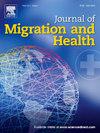Exploring health literacy among Japanese and international university students in Japan: A comparative cross-sectional study
IF 2.9
Q1 PUBLIC, ENVIRONMENTAL & OCCUPATIONAL HEALTH
引用次数: 0
Abstract
Objective
Health literacy (HL) is the ability to access, understand, evaluate, and apply health information for well-being. However, comparisons between domestic and international students remain limited. This study aims to investigate HL among Japanese and international university students in Japan and explore the factors that influence it.
Methods
This cross-sectional study used both the English and Japanese versions of the 47-item European Health Literacy Survey Questionnaire (HLS-EU-Q47). Using convenience sampling, a total of 1366 university students across six regions in Japan who provided informed consent participated in this self-administered, online-based survey. Descriptive statistics, t-tests, ANOVA and multiple regression were conducted as appropriate at a 0.05 alpha level using JMP statistical software (version 17.0.0)
Results
The results revealed that 60 % and 32 % of participants had inadequate and problematic HL, respectively, indicating that 92 % of all students had limited HL. International students exhibited better HL than Japanese university students (p < 0.0001), a difference that remained after adjusting for sociodemographic and educational factors (β = 3.39, 95 % confidence interval = 2.83 – 3.95, p < 0.0001). The competency of “appraising” within the healthcare domain presented the greatest challenge for international students, whereas “understanding” within the disease prevention domain was most difficult for Japanese students. Furthermore, the results indicated a strong association between HL and sociodemographic factors such as age, level of study, marital status, and religious affiliation. In contrast, health literacy showed an inverse association with economic status, program of study and parental education level. There was an observable trend between improved Japanese language proficiency and improved HL among international students.
Conclusion
International students in Japan demonstrated better HL than Japanese university students. Educational institutions must take a more proactive role in fostering HL for all students through general health education and peer-to-peer programs to create a more informed, healthy, and productive student community.
日本大学生与国际大学生健康素养探讨:一项比较横断面研究
目的健康素养(HL)是获取、理解、评估和应用健康信息的能力。然而,国内学生和国际学生之间的比较仍然有限。本研究旨在调查日本和在日留学生的HL,并探讨影响HL的因素。方法本横断面研究采用英文和日文两种版本的欧洲健康素养调查问卷(HLS-EU-Q47)。采用方便抽样,日本六个地区共有1366名提供知情同意的大学生参加了这项自我管理的在线调查。采用JMP统计软件(17.0.0版),在0.05 alpha水平下进行描述性统计、t检验、方差分析和多元回归分析。结果结果显示,60%和32%的参与者分别患有不充分的HL和有问题的HL,表明92%的学生患有有限的HL。国际学生比日本大学生表现出更好的HL (p <;0.0001),在调整社会人口统计学和教育因素后仍然存在差异(β = 3.39, 95%置信区间= 2.83 - 3.95,p <;0.0001)。对国际学生来说,保健领域的“评价”能力是最大的挑战,而对日本学生来说,疾病预防领域的“理解”能力是最困难的。此外,研究结果表明,HL与年龄、学习水平、婚姻状况和宗教信仰等社会人口因素有很强的相关性。健康素养与经济状况、学习计划、父母教育程度呈负相关。国际学生日语水平的提高与语言能力的提高之间存在显著的趋势。结论在日留学生的HL表现优于日本大学生。教育机构必须通过普通健康教育和点对点项目,在培养所有学生的HL方面发挥更积极的作用,以创造一个更知情、更健康、更有成效的学生社区。
本文章由计算机程序翻译,如有差异,请以英文原文为准。
求助全文
约1分钟内获得全文
求助全文
来源期刊

Journal of Migration and Health
Social Sciences-Sociology and Political Science
CiteScore
5.70
自引率
8.70%
发文量
65
审稿时长
153 days
 求助内容:
求助内容: 应助结果提醒方式:
应助结果提醒方式:


